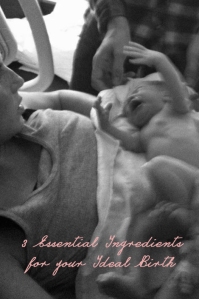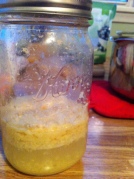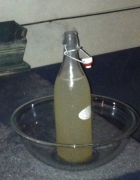 Whenever I meet expectant parents, I get a crazy look in my eye, my heart begins to race, and I want to spew out all that I have learned about pregnancy and birth. I want to share all the things that I wish I knew early on in my pregnancy or better yet, before getting pregnant. However, I usually hold back from giving my birth sermon because I know that expectant parents are probably already getting flooded with unwanted advice. I don’t wish to add to the unwanted advice. I don’t want to be annoying or condescending. So instead of ranting to those who do not care what I have to say, I will passively sit and write this post with hopes that those who do care will read. Here is my list of 3 Essential Ingredients for your Ideal Birth.
Whenever I meet expectant parents, I get a crazy look in my eye, my heart begins to race, and I want to spew out all that I have learned about pregnancy and birth. I want to share all the things that I wish I knew early on in my pregnancy or better yet, before getting pregnant. However, I usually hold back from giving my birth sermon because I know that expectant parents are probably already getting flooded with unwanted advice. I don’t wish to add to the unwanted advice. I don’t want to be annoying or condescending. So instead of ranting to those who do not care what I have to say, I will passively sit and write this post with hopes that those who do care will read. Here is my list of 3 Essential Ingredients for your Ideal Birth.
Let go of fear. We have been conditioned to fear childbirth and it is reinforced EVERYWHERE. It’s reinforced by lazy writers (Downton Abbey season 3 anyone?) and by loved ones with the best intentions. When I decided that I wanted to have a natural birth, I had to fight the fear being placed on me by those I am closest with. My mom told me that it is something I could do for subsequent children, but it would be too painful for my first. My sister told me of a neighbor who waited off on getting an epidural while in labor because she wasn’t in pain, but couldn’t get one when she was in pain, thus having to endure an excruciating transition and a severe tear. It’s natural to fear the unknown, but ultimately we do more harm than good when we harbor these fears within ourselves and encourage the fear in others. Fear based decisions can hold us back from achieving our goals. I’ve heard of way too many women who make fear based decisions in childbirth that ultimately keep them from having their ideal birth. Release your fears concerning birth and allow yourself to dream. You can have a painless birth. You can have a birth that brings you closer to the divine. You can have a vaginal delivery after a cesarean. If other women have done it before, believe that you can too. Maybe there will be unforeseen events, it’s possible. Do not dwell on the improbable worst case scenario, rather prepare yourself for the best possible scenario. We often get what we focus on.
Have a clear vision of your ideal birth. Your baby’s birth day can be something beautiful, serene, and unique, a day that will ultimately change you and your family for the better. Realize that there are birth options. Your birth deserves as much thought and planning as you put into your wedding day. Study the options and form your own passionate opinions. Where will you birth? What will you wear? Who will be attending? Will you and your body be treated with respect? What will you eat and drink? You have the right and the responsibility to protect how you, your body, and your baby are treated. An epidural is not the only way to mitigate pain. You can decline routine cervical exams. You don’t have to watch your baby get pricked by needles on his or her first day of life. The hepatitis B vaccination can be delayed or refused. You can administer vitamin K to your baby orally instead of injecting them with a syringe. You do not need to be strapped on a hospital bed for monitoring. You can move about freely in accordance to what feels best to you. You can labor, even birth, in a bath. You can get a massage. You deserve to feel pampered, loved, and cared for on this day. Take a few minutes every day to meditate and visualize your ideal birth. You can make it happen.
Find a care provider who will honor your vision. Once you have an idea of how your ideal birth will go, write it out. Prepare your birth plan with care and discuss it with your care provider as early as possible. I felt uncomfortable with the first doctor I visited. So I fired him. I found a new doctor and she discussed every aspect of my birth plan with me. She shared with me legitimate concerns over some items in my birth plan and gave me hearty approval over others. Overall, discussing my birth plan with her greatly increased my confidence in her ability to honor my wishes and it increased my confidence in my ability to achieve my ideal birth. Though your care provider may not agree with you on every detail of your ideal birth, be sure that he or she respects your vision. Be sure to check his or her background as well. If you want a natural birth but your doctor has a high rate of administering c-sections or inducing their clients, it is likely that he or she will not honor your vision. If you suspect that your doctor will not honor your vision, do not be afraid to hunt out a new care provider. If that is not a possibility, consider hiring a doula who will be your advocate.
“Remember this, for it is as true and true gets: Your body is not a lemon. You are not a machine. The Creator is not a careless mechanic. Human female bodies have the same potential to give birth as well as aardvarks, lions, rhinoceri, elephants, moose, and water buffalo. Even if it has not been your habit throughout your life so far, I recommend that you learn to think positively about your body.” -Ina May Gaskin













